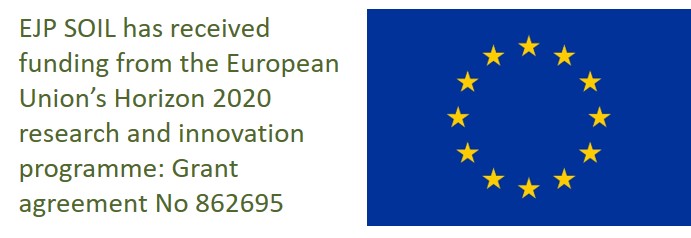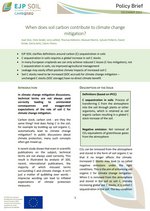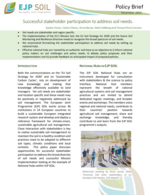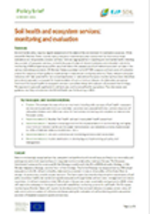Policy briefs
2024
Outputs from EJP SOIL & EJP SOIL funded projects
Rewetting of drained peatlands provides permanent and fast GHG mitigation
Rewetting of previously drained agricultural peat soil coupled with continued cultivation in the form of paludiculture is not widely practiced, and experiments are needed to understand its environmental impacts.
In the INSURE project (INdicators for SUccessful carbon sequestration and greenhouse gas mitigation by REwetting cultivated peat soils) we measured GHG emissions and crop yields in rewetted agricultural fields.

From Risk to Resilience: Policy challenges for Soil Erosion Control
Water-induced soil erosion is a growing concern in the EU, with climate change projections indicating a potential 13-23 % rise in erosion rates.
The variability of soil erosion modelling techniques highlights the need for standardisation of data sets and harmonisation of model parameterisation to allow valid comparisons of policy measures.
The Common Agricultural Policy (CAP) has a limited effect in decreasing erosion risk, as the voluntary measures are often not well targeted to the identified erosionprone areas.
Policymakers should advocate for targeted erosion mitigation measures and elaborate more appropriate assessment protocols including sediment connectivity modelling to improve accuracy in erosion risk assessments.

A framework for setting soil health targets and thresholds in agricultural soils
Soil health is defined through soil indicators, which are assessed using targets and/or thresholds. The challenge is that targets and thresholds are highly site-, managementand climate-specific, and there is not yet a validated assessment system with that level of detail.
With policies worldwide being established to promote soil health, there is an urgent need for the development of a system to assess soils.
We explored four approaches to setting targets and thresholds. Based on stakeholder feedback of the approaches, collected in two webinars (EJP SOIL 2023) and case studies of three approaches, we developed a framework that facilitates both choosing the most appropriate target/threshold method for a given context, and using targets and thresholds to promote soil health.

Towards a regulation on carbon removals n the EU: lessons learned from existing experiences
This policy brief aims at providing a concise overview of the current state of CF schemes in and outside Europe and of research findings derived from the WP8 of the EJP SOIL programme and the Road4schemes project. It builds on existing incentive schemes under the European Common Agricultural Policy (CAP, Reg. EU 2021/2116), and in anticipation of the forthcoming European regulation on carbon removals (COM/2022/672 final), which will play a key role in CF in Europe.
In this context, key challenges and policy recommendations to promote the implementation of a common European CF framework are provided.
When does soil carbon contribute to climate change mitigation?
In climate change mitigation discussions, technical terms are not always used correctly leading to unintended consequences and exaggerated expectations of the role of soil C for climate change mitigation.
Carbon stock, carbon sink - are they the same thing? And does fixing C in the soil, for example by building up soil organic C, automatically lead to climate change mitigation? In public discussions about climate protection, many such concepts often get mixed up.
2023
Outputs from EJP SOIL & EJP SOIL funded projects
2022
Outputs from EJP SOIL & EJP SOIL funded projects
HOW TO BETTER INTEGRATE SOIL MANAGEMENT PRACTICES INTO CLIMATE CHANGE ADAPTATION STRATEGIES
Output from the CLIMASOMA project. Identified and summarized socio-economic and political barriers and incentives for the application of soil and crop management in climate adaptation strategies. The results presented are from a stock-take of EU policies and their instruments that impact agricultural management and barriers and drivers at the farm level in relation to improving soil health and climate change adaptation. The work includes perceptions of barriers and drivers that co-determine the willingness of farmers to act and adapt to climate change
SOIL AND CROP MANAGEMENT PRACTICES FOR CLIMATE ADAPTATION
This policy brief contains information that is crucial to decide which actions to stimulate through policy instruments.This brief contains:
-
Investigated implications of agricultural management practices for soil hydrological functioning under European agro-environ - mental conditions as a part of the European Joint Partnership Soil.
-
Synthesized results of 36 selected meta-analyses 1 (representing data from 2803 unique studies) studying the impact soil and crop management practices on soil hydrological functioning.
-
Identified effectiveness of the selected practices, and also remaining knowledge gaps.
-
Important trade-offs and synergies related to crop production, water quality, and greenhouse gas emissions were also assessed based on the results of additional published meta-analyses.
Education and Capacity building
SOIL SCIENCE IN HIGHER EDUCATION IN EUROPE Current state and recommendations
-
Support European collaborations in soil science higher education
-
Future soil experts need new skills and knowledge
-
Expand opportunities for vocational, professional and lifelong learning
Language versions:





